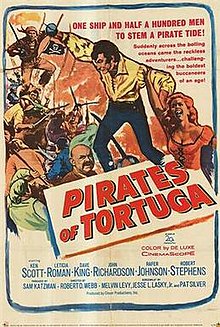Pirates of Tortuga
| Pirates of Tortuga | |
|---|---|
 | |
| Directed by | Robert D. Webb |
| Written by | Jesse Lasky Jr.(as Jesse L. Lasky Jr.) Pat Silver Melvin Levy (and story) |
| Produced by | Sam Katzman |
| Starring | Ken Scott Letícia Román Dave King John Richardson |
| Cinematography | Ellis W. Carter |
| Edited by | Hugh S. Fowler |
| Music by | Paul Sawtell Bert Shefter |
Production company | Clover Productions |
| Distributed by | Twentieth Century Fox Film Corporation (USA) |
Release date | October 1961 (USA) |
Running time | 97 min. |
| Country | United States |
| Language | English |
| Budget | $675,000[1] |
Pirates of Tortuga is a 1961 American Swashbuckler film which invented an alternate history for the actual Welsh privateer Henry Morgan. It was released in October 1961 in the United States.
Plot
A Welsh captain and his crew are dispatched to the Spanish-controlled island of Tortuga, where famed privateer Henry Morgan has defected from his support of the English Empire and is running a strictly piratical venture, stopping any and all vessels including English. Since the captain cannot attack the island without incurring the wrath of the Spanish government, he must go toe-to-toe with Morgan himself.
A comely female has inadvertently ended up as a stowaway on the captain's vessel, and she becomes the de facto central focus of the story (Morgan doesn't appear until the latter half of the film). She is initially deposited on the island, where she makes a half-hearted play for the governor, but eventually re-adjusts her sights on the captain himself. In the meantime, the captain is fully engaged in pursuing the pirate.
Cast
- Bart (captain): Ken Scott
- Meg: Letícia Román
- Pee Wee: Dave King
- Percy: John Richardson
- John Gammel: Rafer Johnson
- Henry Morgan: Robert Stephens
- Phoebe: Rachel Stephens
- Captain Montbars: Stanley Adams
- Sir Thomas Mollyford: Edgar Barrier
- Reggie: James Forrest
- Major Fielding: Maxwell Reed
- Randolph: Patrick Sexton
- Bonnett: Arthur Gould-Porter
- Lola: Hortense Petra
- Kipper: Malcolm Cassell
Production values
Twentieth-Century Fox produced a run-of-the-mill B-movie pirate adventure, using actors little-known in the United States (the female lead was an Italian starlet whose English accent hovered between Cockney and Sicilian, and whose screen presence was compared to a sexy turnip), and inserting footage from other more notable seafaring-adventure films. The storyline was fiction; thus using a real historical figure (Morgan) and endowing him with imaginary traits and actions left viewers feeling disoriented. The movie was not presented as a first-run release, and soon began appearing on late-night television reruns.
References
- ^ Solomon, Aubrey. Twentieth Century Fox: A Corporate and Financial History (The Scarecrow Filmmakers Series). Lanham, Maryland: Scarecrow Press, 1989. ISBN 978-0-8108-4244-1. p253
